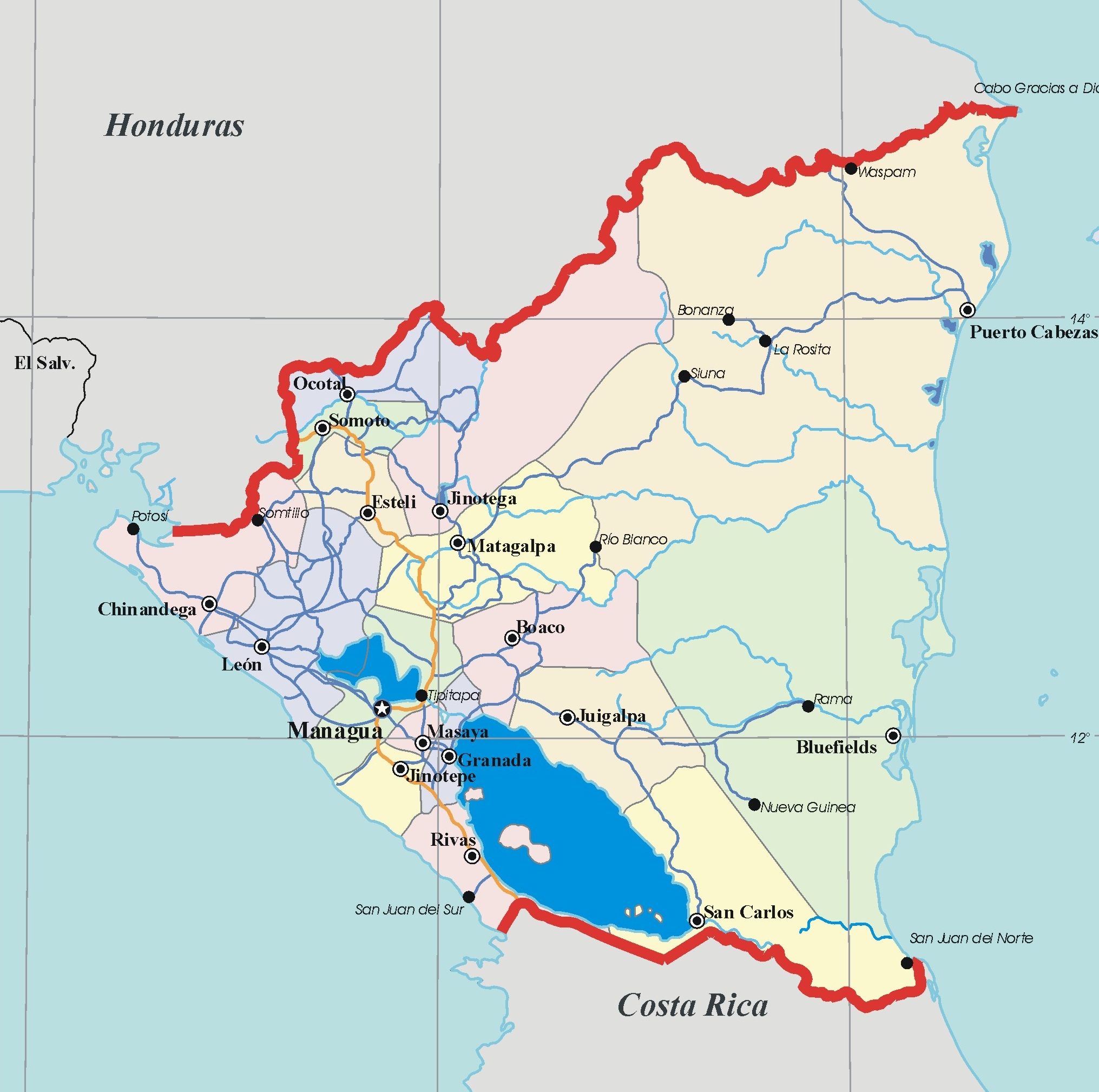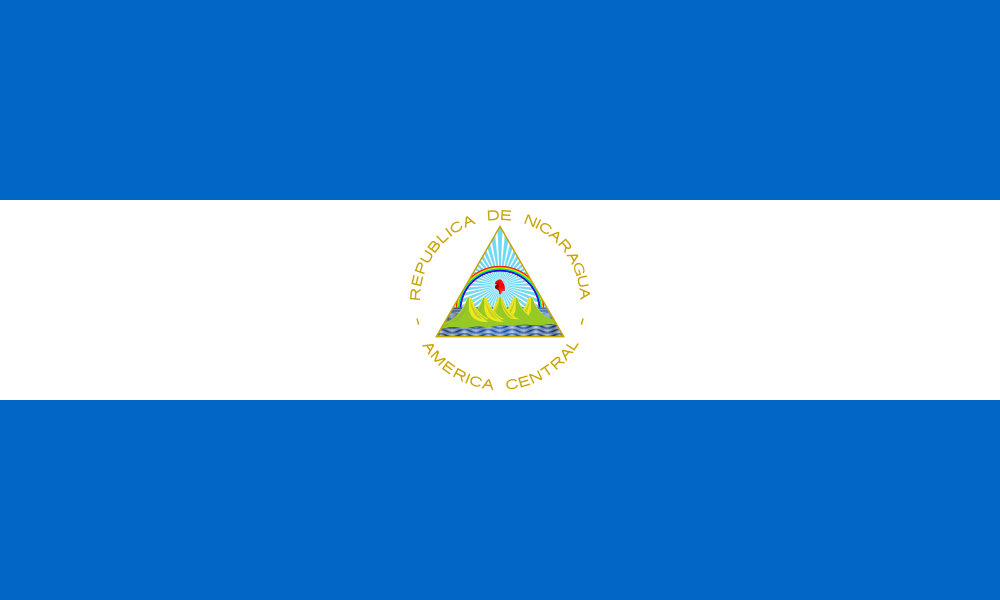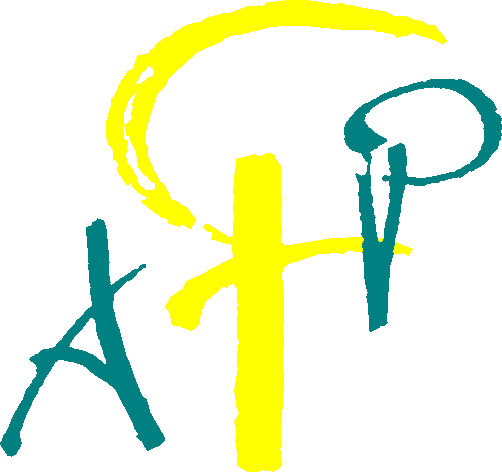Nicaragua
Map - Flag

 Area: 129.494 km² / Population: 6.000.000
Area: 129.494 km² / Population: 6.000.000
Information
Nicaragua, officially the Republic of Nicaragua, is the largest country in the Central American isthmus, bordering Honduras to the north and Costa Rica to the south. The Pacific Ocean lies to the west, and the Caribbean Sea to the east. On the Pacific side of the country are the two largest fresh water lakes in Central America—Lake Managua and Lake Nicaragua. Surrounding these lakes and extending to their northwest along the rift valley of the Gulf of Fonseca are fertile lowland plains, with soil highly enriched by ash from nearby volcanoes of the central highlands.
The population of Nicaragua, approximately 6 million, is multiethnic. Its capital, Managua, is the third-largest city in Central America. Segments of the population include indigenous native tribes from the Mosquito Coast, Europeans, Africans, Asians, and people of Middle Eastern origin. The main language is Spanish. The mixture of cultural traditions has generated substantial diversity in art and literature, particularly the latter given the various literary contributions of Nicaraguan poets and writers, including Rubén Darío, Pablo Antonio Cuadra and Ernesto Cardenal.
The biological diversity, warm tropical climate, and active volcanoes make Nicaragua an increasingly popular tourist destination.
History
Colonial era
The Spanish Empire conquered the region in the 16th century. Nicaragua achieved its independence from Spain in 1821. Since its independence, Nicaragua has undergone periods of political unrest, dictatorship, and fiscal crisis.
In 1502, Christopher Columbus was the first European known to have reached what is now Nicaragua as he sailed southeast toward the Isthmus of Panama. On his fourth voyage, Columbus explored the Miskito Coast on the Atlantic side of Nicaragua.
The first Spanish permanent settlements were founded in 1524. Conquistador Francisco Hernández de Córdoba founded two of Nicaragua's principal towns in 1524: Granada on Lake Nicaragua was the first settlement, followed by León at a location west of Lake Managua. In 1610, the Momotombo volcano erupted, destroying the capital. It was rebuilt northwest of what is now known as the Ruins of Old León.
Independence
Rivalry between the liberal elite of León and the conservative elite of Granada characterized the early years of independence and often degenerated into civil war, particularly during the 1840s and 1850s. Invited by the Liberals in 1855 to join their struggle against the Conservatives, a United States adventurer and filibuster named William Walker set himself up as president of Nicaragua, after conducting a farcical election in 1856. Costa Rica, Honduras, and other Central American countries united to drive Walker out of Nicaragua in 1857, after which a period of three decades of Conservative rule ensued.
Throughout the late 19th century, the United States (and several European powers) considered a scheme to build a canal across Nicaragua, linking the Pacific Ocean to the Atlantic.
USA intervention (1909-33)
U.S. Marines occupied Nicaragua from 1912 to 1933, except for a nine-month period beginning in 1925. In 1914, the Bryan-Chamorro Treaty was signed, giving the U.S. control over the proposed canal, as well as leases for potential canal defences. Following the evacuation of U.S. Marines, another violent conflict between liberals and conservatives took place in 1926, which resulted in the return of U.S. Marines.
From 1927 until 1933, Gen. Augusto César Sandino led a sustained guerrilla war first against the Conservative regime and subsequently against the U.S. Marines, who he fought for over five years. When the Americans left in 1933, they set up the Guardia Nacional (National Guard), a combined military and police force trained and equipped by the Americans and designed to be loyal to U.S. interests.
A growing hostility between Sandino and Somoza, however, led Somoza to order the assassination of Sandino. Fearing future armed opposition from Sandino, Somoza invited him to a meeting in Managua, where Sandino was assassinated on February 21, 1934, by soldiers of the National Guard.
Somoza dynasty (1927-1979)
Nicaragua has experienced several military dictatorships, the longest being the hereditary dictatorship of the Somoza family, who ruled for 43 years during the 20th century. The Somoza family came to power as part of a US-engineered pact in 1927 that stipulated the formation of the Guardia Nacional to replace the Marines who had long reigned in the country. Somoza slowly eliminated officers in the National Guard who might have stood in his way, and then deposed Sacasa and became president on January 1, 1937, in a rigged election.
The Somoza family was among a few families or groups of influential firms which reaped most of the benefits of the country's growth from the 1950s to the 1970s.
The 1972 earthquake destroyed nearly 90% of Managua, creating major losses. Instead of helping to rebuild Managua, Somoza siphoned off relief money. Anastasio Somoza Debayle was deposed by the Sandinistas in 1979
Nicaraguan Revolution
The Sandinistas took power in July 1979. The Carter administration decided to work with the new government, while attaching a provision for aid forfeiture if it was found to be assisting insurgencies in neighbouring countries. Somoza fled the country and eventually ended up in Paraguay, where he was assassinated in September 1980, allegedly by members of the Argentinean Revolutionary Workers Party.
In 1980, the Carter administration provided aid to Nicaragua under the Sandinistas, but the aid was suspended when it obtained evidence of Nicaraguan shipment of arms to El Salvadoran rebels. In response to the coming to power of the Sandinistas, various rebel groups collectively known as the Contras were formed to oppose the new government. The Reagan administration authorized the CIA to help the Contra rebels with funding, armaments, and training. The Contras operated out of camps in the neighbouring countries of Honduras to the north and Costa Rica to the south. They engaged in a systematic campaign of terror amongst the rural Nicaraguan population to disrupt the social reform projects of the Sandinistas.
After the U.S. Congress prohibited federal funding of the contras in 1983, the Reagan administration continued to back them by covertly selling arms to Iran and channelling the proceeds to the contras (the Iran–Contra affair). The International Court of Justice, in regard to the case of Nicaragua v. United States in 1984, found, "the United States of America was under an obligation to make reparation to the Republic of Nicaragua for all injury caused to Nicaragua by certain breaches of obligations under customary international law and treaty-law committed by the United States of America". During the war between the contras and the Sandinistas, 30,000 people were killed.
1990s and the post-Sandinista era
Violeta Chamorro in 1990 became the first female president democratically elected in the Americas.
In the Nicaraguan general election, 1990, a coalition of anti-Sandinista parties (from the left and right of the political spectrum) led by Violeta Chamorro, the widow of Pedro Joaquín Chamorro Cardenal, defeated the Sandinistas. The defeat shocked the Sandinistas, who had expected to win.
In the 2001 elections, the PLC again defeated the FSLN, with Alemán's Vice President Enrique Bolaños succeeding him as President. Subsequently, however, Alemán was convicted and sentenced in 2003 to 20 years in prison for embezzlement, money laundering, and corruption.
Legislative and presidential elections took place on November 5, 2006. Daniel Ortega returned to the presidency with 37.99% of the vote. This percentage was enough to win the presidency outright, because of a change in electoral law which lowered the percentage requiring a runoff election from 45% to 35%. Nicaragua's 2011 general election resulted in re-election of Daniel Ortega. In 2014 the National Assembly approved changes to the constitution allowing Daniel Ortega to run for a third successive term.

